Travels to Angkor, Siem Reap, Cambodia: Part I
Travels to Angkor, Siem Reap, Cambodia: Part II
Travels to Angkor, Siem Reap, Cambodia: Part III
We woke up really early on our last day of our Angkor temples visit. We got up at 4.30 am and got ourselves ready for Sakhorn to pick us up at 5 am. We stealthly made our way down the stairs so as not to disturb anyone, though there were no other guests. We got to the main door of our gh, but when I tried to pull the left door, I realised that it was locked by chains. The rambling of the chains caused the two resident dogs bark out loud. The racket broke the silence and woke 'madam', who was sleeping in the first room on the ground floor. She came out from the room, turned on the porch (which was converted to the dining area) lights and unlocked the chains on the right door. She went out and nudged one of the caretaker who was sleeping soundly in his make-shift bed with a mosquito net. On the contrary, he was supposedly the night watch, but seems like even the dog's barkings could not even wake him up. He opened the gate for us to get out. It was chilly outside, early in the morning; I wonder if it was due to the sudden storm last night. Sakhorn soon arrived and we headed off to catch sunrise at Angkor Wat. We paid Sakhorn US$5 for making this early trip which was not part of the packaged itinerary.
We reached Angkor Wat at around 6.15 am. There were already quite a lot of tourists. I 'action-front' (set up/prepare) my Manfrotto tripod and started taking some shots of the dark blue sky. There were a lot of photographers equipped with top-class equipments, especially the Canon white 'L-lenses'. However, we were all disappointed when there was actually a patch of cloud blocking the sun. By around 7am, the sky was rather bright, but the sun was still not in sight, as it was blocked. Many enthusiastic photographers and tourists' moods were dampened. I was rather disappointed too, but nevertheless, managed to get a few decent shots in Angkor Wat without much tourists. At around 7.15-7.30 am, most of the tourists who were here for sunrise, had left Angkor Wat, while the main groups of tourists were not here yet. It seems that tourist groups tend to pour into Angkor Wat at around 8 am.
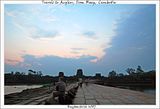
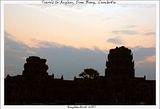
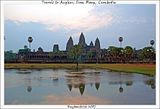
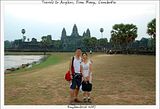
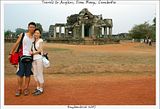
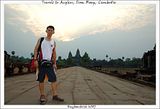
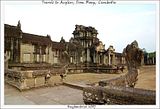
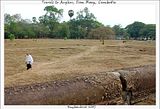
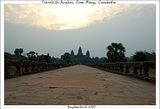
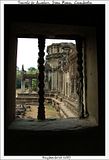
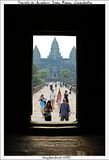
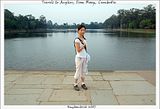
Standing on the causeway, behind is the huge moat surrounding the Angkor Wat.
After Angkor Wat, we went back to our gh for breakfast. At 9 am, Sakhorn was back at the gh, ready to pick us up for our trip to the Roluos Group. Learn more about Roluos Group. Along the way, I took plenty of shots of daily Siem Reap life from my tuk-tuk. It was definitely very interesting seeing how the Cambodian people go about their daily activites/routine.
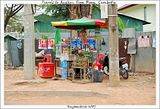
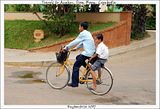
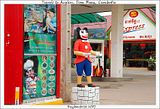
Center shows two siblings getting to work and school, on a bicycle.
Right shows a replica of Mickey at a petrol kiosk.
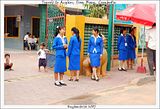
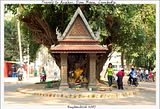

Center shows a worshipped temple in the middle of the cross junction, under a huge tree.
Right shows a man watering the floor to prevent dust.
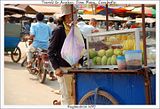

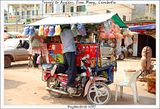
Center shows a market, bustling with life.
A motor-cart selling toys and clothes.
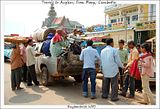
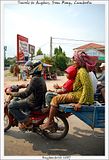
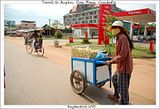
Left shows people packing up onto a small pick-up.
Right shows a curious sugarcane cubes seller.
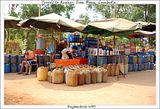
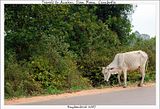
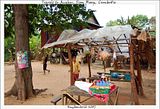
Left shows people selling petrol or diesel.
Right shows a shed at the front of a house made by the owner, for activities or small businesses.
The first temple of the Roluos Group that we visited, was the Preah Ko. Learn more about Preah Ko. This temple is also known as the 'Sacred Bull', attributed to the three kneeling Nandis corroborate the temple's dedication to Shiva. In the temple, there once stood the Hariharalaya, the 'Seat of Harihara' which was dedicated to the Vishnu and Shiva.
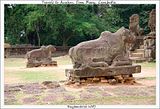
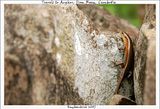
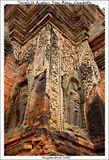
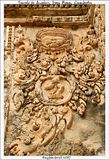
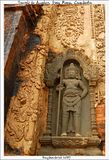
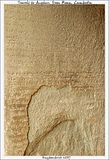
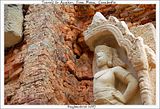
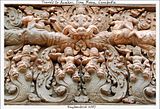
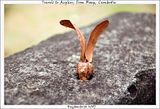
The second temple of Roluos Group we visited was Bakong. Learn more about Bakong. Bakong is the official temple of the Hariharalaya. The base of the temple is a five-tiered pyramid, believed to present the five earthly realms of snakes (nagas), birds (garudas), demons (rakshasas), nature-spirits (yakshas), and kings (rajas).
Around Bakong, there is a community of locals living there. Since it was a weekday, children can be seen in school uniforms. I guess it was after classes, children were hanging around the temples. They were so used to begging for money from tourists, a simple US$1 will please them. I would not hesitate to give them, but it might encourage them to think of begging as a source of income and make them dependent.

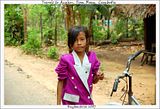
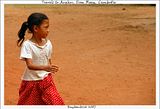
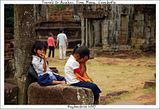
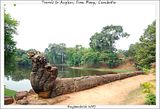
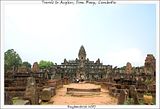
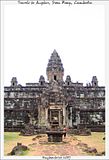
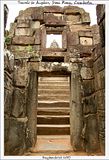
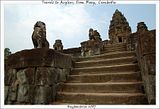
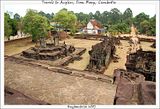
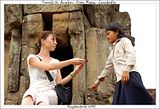
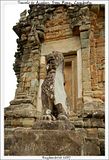
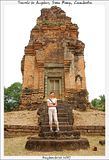
Left shows the top central prasat surrounded by stone lions.
Lolei was the last of the Roluos Group temples which we visited. Learn more about Lolei. Lolei is a small compound where six prasats stood in a 3 by 2 orientation. There was nothing much of Lolei to explore as the whole compound has been surrounded by a barrier. Much of the existing damage, by part caused by tourists touching them, makes the compound unsafe for entering.
After visiting Roluos, Sakhorn suggested that we visit Beng Mealea for an additional US$30 for two of us. Learn more about Beng Mealea. Beng Mealea was hidden within thick jungles for centuries and has only been discovered lately. This magnificent temple was said to be Pre-Angkorian, preceeded and was a template for the Angkor Wat. The regular Angkor pass is not required but it takes 1-2 hours on a good 63km road from Siem Reap town. An entrance fee of US$5 is required before entering Beng Mealea. Some people swore by its ancient grandeur and beauty, while we decided pass and to take the rest of our day exploring the bas-relief of Bayon and Angkor Wat in detail.
Before all that, we had lunch back at Khmer Village Restaurant, which we had visited earlier. This time we had something different. I ordered a fresh coconut drink, strangely, they only cut a small opening at the top, fit for a straw. I wondered if they have the habit of eating the coconut flesh. We had stir-fried beef with mushrooms and Amok fish. As I have mentioned earlier in Part II of my post. I had Amok fish at the Dead Fish Tower. The Amok fish served at this restaurant was different. There was no white cabbage and otar, but they had a thick coat of shredded spinach layered over the fish drowned in flavour-rich coconut syrup. The serving style was also different from that in the Dead Fish Tower, but still tasted great!
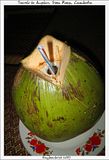
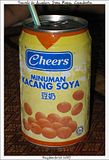
A cooling coconut drink and cheers to a soya bean drink.
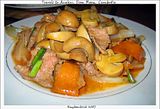
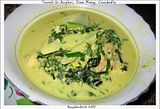
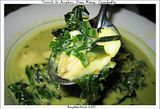
Stir-fried beef with mushrooms and my favourite Amok fish.
We had missed Ta Keo earlier and so we visited it after lunch. Learn more about Ta Keo. Ta Keo is another tall temple built on a five-tiered pyramid, but was incomplete. However, the view from the top was great! We took some time relaxing up by the door steps of the central temple and enjoyed the breeze in the scorching noon sun.
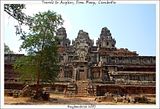
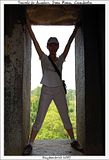
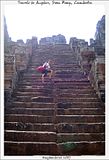
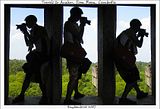
We soon found ourselves back in the gallery of The Bayon (visited earlier in Part II). The outer gallery walls of The Bayon was famous for its bas-relief documenting the Khmer history in detail.
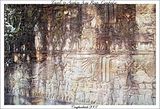
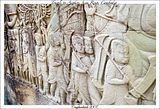
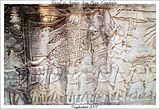
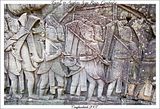
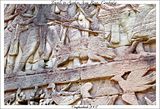
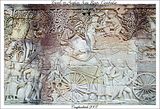
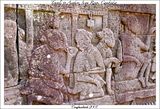
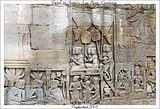
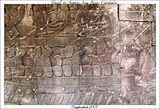
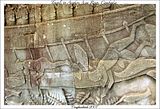
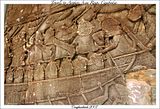
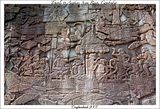
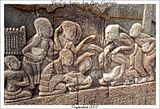
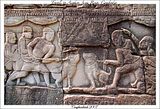
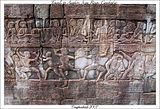

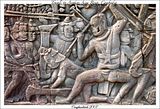
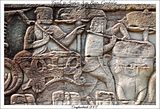
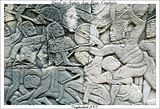
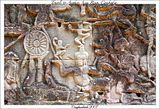

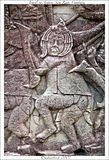
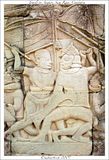

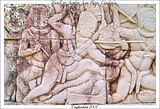
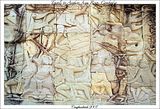
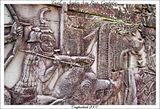
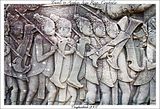
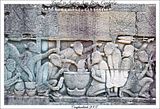
Left shows a Cham commander leading his men forward.
The next stop was Angkor Wat (visited earlier in Part II). There is also plenty of bas-relief on the outer gallery walls depicting scenes of religious Hinduism significance, instead of historical events (as in The Bayon). During our visit, the authorities had layed a rope as barrier, to prevent tourists from touching the bas-relief, as you can see that the years of touching had made the relief smooth and shiny, some even loosing its definition and depth. We started off from the west gopura and explored in a counter-clockwise motion.
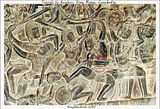
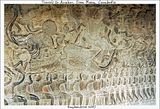
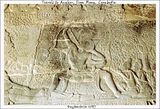
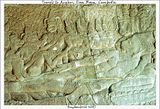
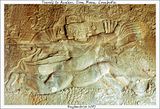
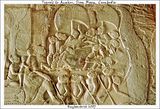
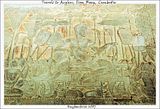
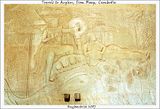
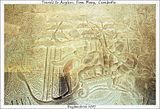
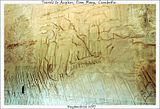
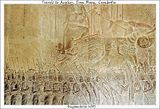

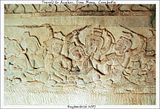
Churning the Ocean of Milk
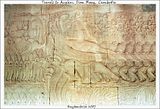

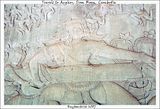

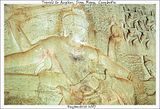
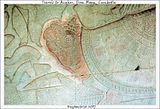
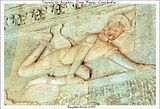
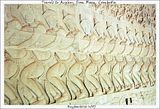
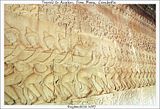
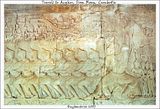
After our tour, it marked the end of our three days Angkor tours. Sakhorn brought us to another souvenier shop, but there was nothing much to buy. We dropped off at Old Market area and visited The Red Piano restaurant. The Red Piano is made famous after its visit by Angelina Jolie, during the filming of Tomb Raider. The restaurant also had a cocktail named after the famous celebrity. We were early and found ourselves a good seat overlooking the 'Pub Street' of the Old Market precint. The bottled soft drinks came free with our meals, available only till 8pm. We did not order any Khmer food, but instead had Thai curry and I ordered a Gordon Blue.
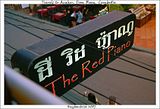
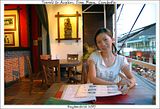
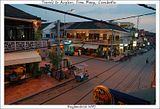
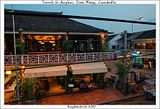
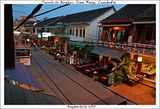

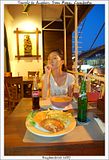
Getting impatient waiting for me to snap pictures of the food before digging in.
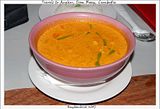
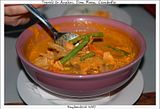
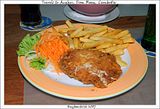
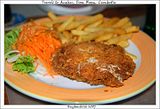
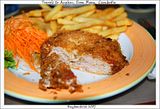
Keep watching this blog for more updates. Next up is the last day we spent in Siem Reap, where I give an account of my free and easy visit around Siem Reap town.
technorati tags
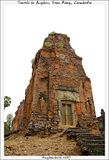
No comments:
Post a Comment